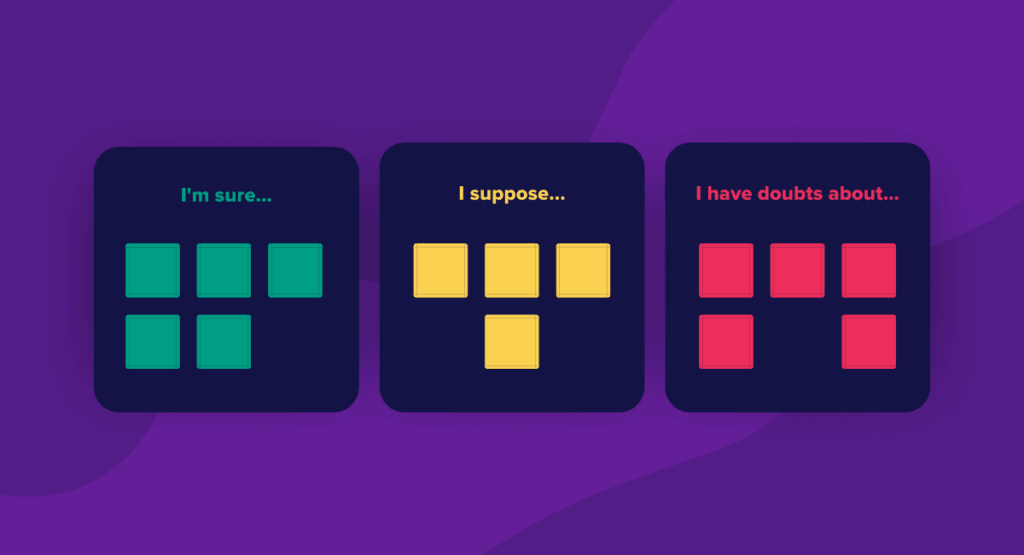The CSD Matrix is a great tool to apply at the beginning of a project, as it will organize and direct your actions during this new challenge – like the development of a mobile app, website, or software. This is a Brazilian adaptation of the "Knowns and Unknowns" framework, whose acronym CSD comes from the Portuguese words "Certezas", "Suposições", and "Dúvidas", which refer to "Knowns", "Unknowns" and "Questions".
This framework is widely used in product management and, therefore, very common in UX and Product Design.
If you are starting a new project and don't know where to start or need to gather data to solve a problem, keep reading!
What is the CSD Matrix?

The CSD Matrix was created by Livework, a pioneering consulting firm in Brazil and a world leader in Service Design.
This method is based on three pillars, each one corresponding to a letter of the acronym CSD: Certezas (“Knowns“), Suposições (“Unknowns“), and Dúvidas (“Questions“).
Each column is then filled with information or questions about the project and its context. This information can be about the customer, their needs, desires, pains, about processes, business aspects, etc.
In the Knowns column, the team will include everything they already know, what is already defined and consolidated in the project.
The Unknowns bring hypotheses that you and your team will validate, and in the Questions column, everything that the team doesn't yet know and needs to find out is added.
The CSD Matrix is generally used in the Discovery stage, the initial phase of a project, where the team will gather everything they know about the challenge or problem.
Living tool
It's important to point out that the CSD Matrix is a living framework. The idea is that, as the project develops, certainties, suppositions, and doubts change. So doubts can become certainties, certainties can change, and new suppositions can emerge.
Dividing the project into certainties, suppositions, and doubts helps the product team define strategies to confirm or clarify each of these pieces of information.
This helps stakeholders to think about what needs to be clarified and how this will be done, such as A/B tests or user surveys, guiding the user interview script, for example.
Reading tip: Continuous Discovery: Why Keep on Researching?
How to use the CSD Matrix
The good thing about the CSD Matrix is that it's very practical to apply: all you need is pen and paper. But of course, there are several online tools that can help you with this.
Your team can use a spreadsheet on Google Sheets, post-its, or a wall in the office. If they opt for an online tool, you can use platforms like Trello, Miro, or Mural.
The most important thing is to choose an option that everyone can easily use and that is visible, accessible, and editable to all who participate in the project.
The good thing about choosing an online tool is the easiness of documenting and accessing this information even after the project is completed.
Remember: for best results, update the matrix as the project progresses. Revise it constantly until all doubts are cleared up, certainties validated, and suppositions clarified.
Reading tip: Heart Framework: User-Centric Metrics To Measure User Experience

Knowns
Under Knowns, add everything your team already knows about the project, the customer, or the technology. Put here what you are 100% sure about.
It may seem unnecessary, but don't underestimate the power of this column, especially to guide the next steps of the Discovery.
Always talk to others and try to justify why that information is there.
Unknowns
In this column, you and your team should add everything you think you know. Every supposition that comes up in analysis or in brainstorming should be fitted into this pillar.
What is unknown is not yet a certainty, but it's not a question either. It's a hypothesis that you and your team have formed based on other information.
Tip: When the team does not agree on a piece of information, add it to the Unknowns quadrant. This will avoid arguments and optimize your time.
Questions
Finally, the most crowded column of the CSD Matrix. In this column, put everything that you and your team don't know yet, but need or would like to know.
Add anything that might raise a question, don't hold back! It's from these uncertainties that your Discovery will take shape and focus.
Advantages of using the CSD Matrix
The CSD Matrix helps keep everyone informed about what is being done because it starts from a survey of all the data about the project.
Check out some advantages and benefits of using this method:
- It brings insights that ultimately improve the user experience;
- It's easy to apply;
- It helps to show the project's progress since it shows what still needs to be discovered;
- It can motivate and engage the team;
- It optimizes the productivity of those involved since the matrix organizes the processes;
- It aligns the different perceptions of the team regarding the project;
- It helps guide the user research since the doubts can be validated in interviews;
- It's a great tool to confirm hypotheses in the Discovery stage.
To take even more advantage of the CSD Matrix, the team can add it to other methods that use Design Thinking principles, such as the Empathy Map.
Reading Tip: Bauhaus: Functional Design For People
When to use the CSD Matrix

The CSD Matrix is mainly used at the beginning of a project, but it can also be used at some strategic moments, such as:
During kick-off: meeting to define the project scope and align expectations with the team and customers or stakeholders. At this moment, it's important to extract as much information as possible about the client's objectives in relation to the project's challenge.
Before the exploratory research: as a starting point for the interview script and user observation.
After the research: After the first impressions have been collected, the CSD Matrix can be updated again. It's common to see initial doubts being clarified and moving into the certainty column, as well as certainties going into the suppositions frame.
After a Design Sprint: At the end of a Sprint, many teams meet to evaluate the next steps of the project. In this meeting, the team decides whether to iterate (improve the prototype) or pivot (select a new idea to prototype). In both cases, it's a great time to review the CSD Matrix made at the beginning of the project and validate important information about the user and other aspects.
Extra Tips
The CSD Matrix can and should be a living document, something you can always turn to for inspiration or help. In addition to finding out whether a piece of information is true or false, also add the answer to your document. It can be a link or even a recorded excerpt from an interview. It's very valuable for the team and future projects to know where a conclusion came from.
Whenever discussions begin about what information goes into which category, it's important to remember that diversity of opinion is much more beneficial to the process than consensus. The goal of the tool is to broaden perspectives.
We talk a lot about the importance of diversity in balanced teams, and it's no different here.
So invite other professionals to participate in the process: engineers, brand managers, and researchers; the more diversity, the merrier. Their different perspectives can bring many valuable insights.








